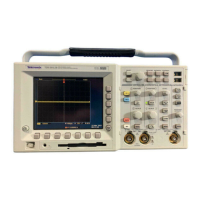Getting Started
1-6
TDS3000B Serie s User Manual
Normal Acquisition. Acquire 10, 000 point waveforms to capture
horizontal detail and the n use the zoom
function to analyze the
detail. See page 3--12.
Fast Trigger Acquisition. Acquire up to 3,600 waveforms per second
(300 MHz -- 600 MHz models, 500 point mode) to see rapidly
changing signals or intermittent signal irregularities. See page 3 --12.
Pretrigger. You can capture signals that occur before the trigger point.
You can position the trigger point at the beginning of the acquisition,
at the end, or at a ny loc at ion in between. See page 3--31.
Delay. You can also delay the acquisition so that it starts after the
trigger point . Use delay when you want to acquire the signal at a
specific time after the trigger point. See page 3 --33.
Peak Detect. See pulses as narrow as 1 ns even at the slower time base
settings. Peak Detect helps you see noise and glitches in your signal.
Seepage3--9.
Signal Processing Features
Average. Apply averaging to your signal to remove uncorrelated noise
and improve measurement accuracy. See page 3 --10.
Envelope. Use envelope to capture and display the maximum
variation of a signal. See page 3--10.
Waveform Math. Use waveform math to add, subtract, multiply, or
divide waveforms. For example, you can use math to analyze
differential signals or calcula te a power waveform. See page 3--84.

